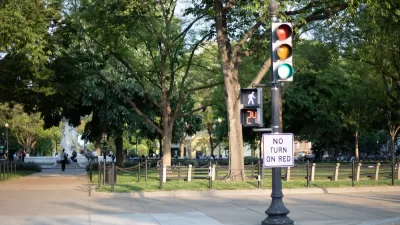The policy, which stems from the gas embargo of the 1970s, makes intersections more dangerous for pedestrians.

In a segment for NPR, Ally Schweitzer highlights a growing movement to ban right turns on red, a 1970s policy that leads to more pedestrian deaths and injuries.
Schweitzer notes Washington, D.C.’s recent decision to prohibit cars from turning right on red lights, adding that San Francisco, Cambridge, Massachusetts, and other cities are doing the same.
According to San Francisco city supervisor Dean Preston, “We saw an 80% decrease in close calls and a 70% decrease in vehicles blocking or encroaching the sidewalks during red lights” after making the change in that city’s Tenderloin district.
Road safety advocates say turning right on red increases the likelihood of car-pedestrian collisions and forces drivers into crosswalks. According to a 2023 Fast Company article, “A 1982 study found that the new policy triggered a sharp increase in crashes involving conflicts between a pedestrian or cyclist and a right-turning vehicle. In Ohio, for instance, such collisions rose 57% for pedestrians and 80% for cyclists; in Wisconsin, the figures were 107% and 72%, respectively.”
If driving through an intersection without stopping may be more fuel-efficient, American cities could consider traffic circles and roundabouts as another option for maintaining traffic flow and reducing congestion.
FULL STORY: More cities are banning right turns on red in response to rising pedestrian deaths

Planetizen Federal Action Tracker
A weekly monitor of how Trump’s orders and actions are impacting planners and planning in America.

San Francisco's School District Spent $105M To Build Affordable Housing for Teachers — And That's Just the Beginning
SFUSD joins a growing list of school districts using their land holdings to address housing affordability challenges faced by their own employees.

The Tiny, Adorable $7,000 Car Turning Japan Onto EVs
The single seat Mibot charges from a regular plug as quickly as an iPad, and is about half the price of an average EV.

Trump Approves Futuristic Automated Texas-Mexico Cargo Corridor
The project could remove tens of thousands of commercial trucks from roadways.

Austin's First Single Stair Apartment Building is Officially Underway
Eliminating the requirement for two staircases in multi-story residential buildings lets developers use smaller lots and more flexible designs to create denser housing.

Atlanta Bus System Redesign Will Nearly Triple Access
MARTA's Next Gen Bus Network will retool over 100 bus routes, expand frequent service.
Urban Design for Planners 1: Software Tools
This six-course series explores essential urban design concepts using open source software and equips planners with the tools they need to participate fully in the urban design process.
Planning for Universal Design
Learn the tools for implementing Universal Design in planning regulations.
Smith Gee Studio
City of Charlotte
City of Camden Redevelopment Agency
City of Astoria
Transportation Research & Education Center (TREC) at Portland State University
City of Camden Redevelopment Agency
Municipality of Princeton (NJ)





























